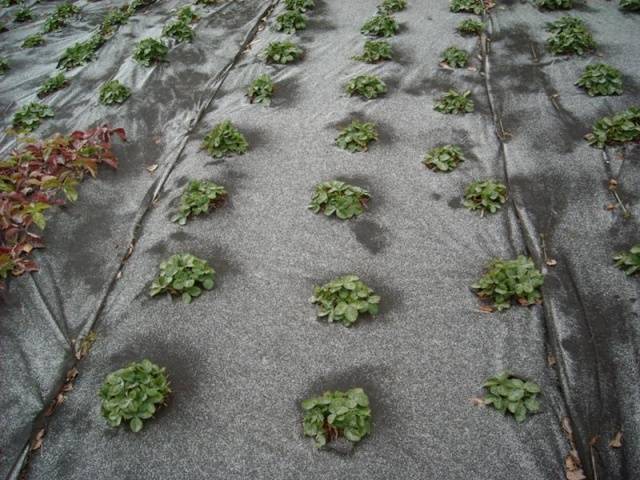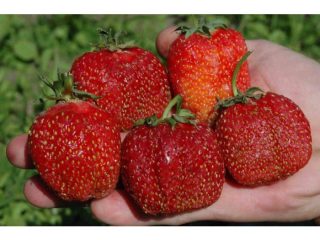Content
Gardeners know how much effort and time is spent on cultivating strawberries. It is necessary to water the seedlings in time, trim the tendrils, remove weeds With beds and don’t forget about feeding. Today, new technologies have emerged to make this hard work easier. Strawberries under agrofibre are grown in a simple and affordable way, which is becoming increasingly widespread.
Agrofibre or, in other words, spunbond is a polymer that has the structure of a fabric fabric and has certain specified properties:
- it perfectly allows air, moisture and sunlight to pass through;
- spunbond retains heat, providing an optimal microclimate for the bed or seedlings;
- at the same time protects strawberries from the penetration of ultraviolet rays;
- agrofibre prevents the growth of weeds in the garden bed;
- protects strawberry seedlings from mold and slugs;
- eliminates the need to use herbicides;
- Also attractive are the environmental friendliness of agrofibre and its fairly low cost.
White spunbond
Agrofibre comes in two types. White is used as a cover for beds after planting strawberries.You can directly cover the bushes themselves with spunbond; it will create a greenhouse effect for them. As the seedlings grow, they lift up light agrofibre. You can also lift the spunbond in advance using curved support rods. When weeding bushes, it can be easily removed and then laid down again. If the density is chosen correctly, then white agrofibre can be kept in the beds from early spring until harvest time.
Black agrofibre
The purpose of black spunbond is exactly the opposite - it has a mulching effect and maintains optimal temperature and humidity in the garden bed, and the necessary dryness for strawberries. Spunbond has other useful properties:
- there is no need for frequent watering of seedlings;
- the garden bed gets rid of weeds;
- microflora does not dry out in the top layer of soil;
- agrofibre prevents the penetration of pests - mole crickets, beetles;
- strawberries remain clean and ripen faster;
- the tendrils of strawberry bushes do not get tangled and do not sprout; you can regulate their reproduction by cutting off the excess ones;
- agrofibre can be used for several seasons.
Advantages of spunbond over film
Agrofibre has a number of advantages over polyethylene film. It retains heat well and during frosts can protect seedlings from the cold. Polyethylene has certain disadvantages:
- strawberries under film are susceptible to such unfavorable factors as overheating of the soil, inhibition of microflora;
- during frosts, condensation forms under the film, which leads to its icing;
- it only lasts for one season.
It is important to choose the right agrofibre in order to effectively use all its beneficial properties. As mulching material For beds, black spunbond with a density of 60 g/m2 is best suited. m. It will serve excellently for more than three seasons. The thinnest variety of white agrofibre with a density of 17 g/m2. m will protect strawberries from excessive exposure to sunlight, heavy rain or hail, as well as from birds and insects. To protect against severe frosts - down to minus 9 degrees, spunbond with a density of 40 to 60 g/m2 is used. m.
Preparing the beds
To plant strawberries on agrofibre, you must first prepare the beds. Since they will be covered for three to four years, thorough work is required.
- First you need to choose a dry area, well lit by the sun, and dig it up. Strawberries under film grow well on slightly acidic, medium-loamy soils. It produces high yields in beds where beans, mustard, and peas were previously planted.
- It is necessary to clear the soil of weed roots, stones and other debris.
- Organic and mineral fertilizers should be added to the soil depending on the type of soil and climatic characteristics of the area. On average, it is recommended to add a bucket of humus with two glasses of wood ash and 100 g of nitrogen fertilizers per square meter of beds. If necessary, you can add sand and mix well or dig again.
- The beds must be thoroughly loosened and leveled. The soil should become loose and light. If after rain the soil is wet and sticky, it is better to wait a few days until it dries.
Laying agrofibre
When the beds are ready, you need to properly lay spunbond on them. To grow strawberries on black film, you need to choose agrofibre of the highest density. It is sold in rolls ranging from one and a half to four meters wide and ten meters long.You should carefully lay the spunbond on the finished bed and carefully secure the edges from gusts of wind. Stones or paving stones are suitable for this purpose. Experienced gardeners secure agrofibre with artificial pins cut from wire. They are used to pin the agrofibre, placing small pieces of linoleum on top of it.
If you need to use several pieces of spunbond, then it must be laid with an overlap of up to 20 cm, otherwise the joints will separate and weeds will grow in the resulting opening in the bed. The agrofibre should fit tightly to the ground, so the row spacing can be additionally mulched with sawdust; it retains moisture well.
Seedling selection
When selecting seedlings, it is advisable to adhere to some rules:
- if strawberries are planted in the spring, it is better to select young bushes, and in the fall - this year’s tendrils;
- strawberry stems and leaves should not be damaged;
- It is better to discard seedlings with rotten roots;
- Before planting, it is good to keep the strawberry bushes in a cool place for several days;
- if strawberry seedlings are grown in cups, you need to dig a hole deeper;
- seedlings grown in open ground do not require a deep hole, since their roots are slightly pruned;
- Before planting, dip each strawberry bush in a solution of clay and water.
Planting seedlings
Growing strawberries on film made of agrofibre has some features. You need to mark the landing pattern on the spunbond fabric. The incision sites are marked with chalk. The optimal distance between strawberry bushes is 40 cm, and between rows - 30 cm.In the marked places, using a sharp knife or scissors, make neat cuts in the form of crosses measuring approximately 10x10 cm, depending on the size of the bush.
Seedlings are planted in the prepared holes.
After planting, each strawberry bush is watered generously.
Proper watering
Strawberries planted on spunbond do not require constant watering, as they do not like high humidity. Abundant irrigation is required only during planting and dry periods. You can water the seedlings from a watering can directly onto the surface of the spunbond. However, a lack of water for strawberries is also harmful; during flowering and ripening, they must be regularly watered about two or three times every week.
The best way is to organize a system drip irrigation:
- water goes directly to the strawberry roots, leaving the row spacing dry;
- it remains in the garden for a long time due to slow evaporation;
- fine spraying evenly distributes moisture in the soil;
- after drying, a hard crust does not form;
- the time for watering seedlings is approximately 25 minutes in the central zone of the country, and a little longer in the southern regions;
- during the strawberry picking period it also approximately doubles;
- drip watering of beds is carried out only in sunny weather;
- Through the drip irrigation system, seedlings can also be fed with mineral fertilizers dissolved in water.
Watering strawberries on agrofibre is shown in the video. A hose or tape with holes is placed in the beds at a depth of several centimeters, and the seedling planting pattern is calculated according to the location of the holes in the tape.Drip irrigation eliminates the hard work of watering your garden beds using a watering can.
Caring for strawberries grown on agrofibre
It is much easier to care for garden strawberries on spunbond than with regular ones:
- with the arrival of spring, it is necessary to remove old yellowed leaves on the bushes;
- trim off excess tendrils, which are easier to notice on spunbond;
- Cover the bed for the winter with white agrofibre of the required density to protect it from frost.
Reviews
Numerous reviews from Internet users indicate that the use of agrofibre when growing strawberries is gaining increasing popularity.
Application of spunbond in greenhouse conditions
Using white agrofibre, you can significantly speed up the ripening time of early varieties of strawberries. Planting of seedlings is carried out in the last week of April or in the first ten days of May. A series of low wire arches are installed above the beds, spaced one meter apart. They are covered with agrofibre on top. One side is secured tightly, and the other should open easily. At both ends of the greenhouse, the ends of the spunbond are tied into knots and secured with pegs. Growing strawberries under agrofibre does not require complex care.It is enough to monitor the temperature inside the greenhouse. It should not be higher than 25 degrees. The seedlings need to be ventilated periodically, especially if the weather is sunny.
Results
Every year modern technologies make the work of gardeners and gardeners more and more easier. Using them, today you can get high yields of your favorite berries, including strawberries, without much difficulty.



















